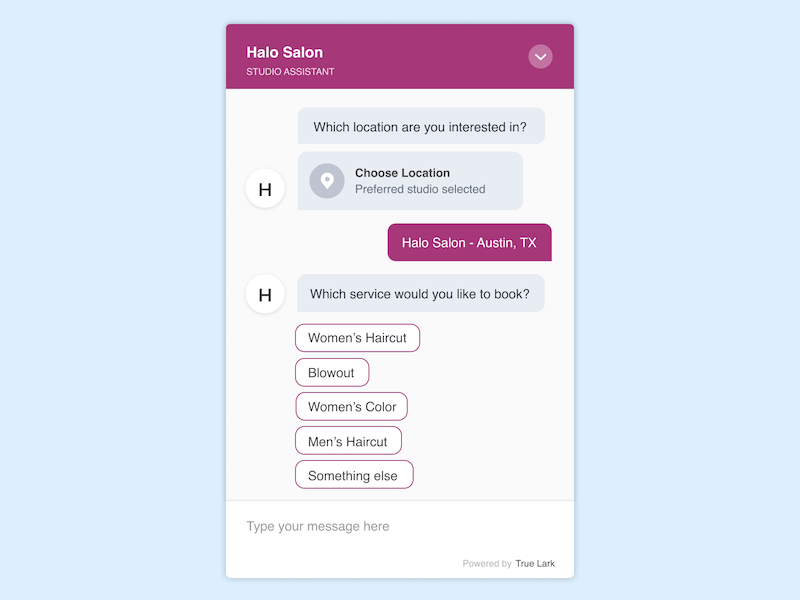Not all AI assistants are created equal. In fact, many that purport to be AI-powered are simply menu-driven chatbots that do more harm than good.
Typically, chatbots designed for business fall short because they don’t really understand what the customer is asking. They’re good with simple questions and uncomplicated situations. But if the customer asks something that is off-script or follows up with a line of questioning that the bot is not programmed to understand—as people often do—the chatbot becomes hopelessly lost.
And customers, on their end, become frustrated and angry. So, a tool that you purchased for the purpose of engaging customers ends up driving them away. And that can cost you real money.
What you need is a truly conversational AI assistant that can better understand your customers. One that can conduct a relationship-based discussion and give customers get the answers they’re looking for. The result is happier customers, increased productivity and greater profitability. The trifecta. And that is what we developed at TrueLark.
Let’s say you’re running a yoga studio. Your customers and prospects are calling your business to ask all sorts of different questions: Can I take a class if I’m six months pregnant? Do you have classes for kids? Is Brianna teaching the 4pm vinyasa flow class tomorrow?
A simple chatbot won’t have the answers. Whereas a conversational AI assistant will be able to listen to what the customer is asking, seek information from you (the business owner) when needed and reply intelligently to as many of the questions as possible.
But don’t get fooled by a chatbot that only pretends to have AI. Here are four questions to ask when trying to distinguish a mindless chatbot from a truly conversational AI assistant.
1: Does it learn over time?
A true AI assistant gets better over time, as it handles more interactions with customers and engages in more conversations. The ability to learn really sets conversational AI apart from traditional chatbots. With each conversation, the AI assistant becomes more capable and intuitive, and builds expertise around your particular business.
The key is the assistant’s ability to continuously learn about human behavior when it converses with people or when it is confronted with new, unscripted situations. To accomplish this, there should be human trainers in the loop, so there is always a second layer of intelligence. These human trainers can also groom the AI so that it speaks in the same style and tone of your brand. With each exchange, the AI becomes more and more independent, building knowledge and experience from thousands of conversations.
Say, for example, you own a hair salon and a customer calls up asking if the hair dye you use is 100% organic. If your AI assistant doesn’t have the answer, it should at that point be able to reach out to a human trainer to get the correct response. That response should then be written into the system, so the AI can provide it the next time it hears the same question.
2: Can it be customized?
Traditional chatbots tend to be highly generic and hard to customize. But today’s conversational AI assistants can be tailored to your exact business requirements and workflows.
Let’s go back to your hair salon. You need an AI assistant that understands how your business operates, including how you book Groupon promotions, how you manage parallel appointments, how you collect credit card information in advance of appointments, how you handle cancellations and a thousand other daily processes. If an AI assistant can’t be customized to fit your business, it’s of limited value.
3: Does it remember my customers and can it engage in personal conversations?
Unlike traditional chatbots, conversational AI remembers everything about your customers’ preferences and can even call customers by their names. It knows what services they have used in the past and even their preferred appointment times. That means it can help grow your business by targeting specific customers with special offers or introducing them to new services.
4: Can it think on the fly?
Say, for example, you own a local fitness center. One of your customers calls to cancel her spot in the 5pm spinning class. An intelligent AI agent will know that spot is now open and that someone else called in yesterday asking about that same time slot. Now it can go back to that customer and see if he still wants the spot. This is just one way an intelligent AI agent can generate more revenue for your business.
AI assistants are starting to play a vital role in today’s digital economy. In fact, Gartner predicts that by 2020 the average consumer will have more conversations with robots each day than with their spouse. The more positive you can make those conversations, the better your business will succeed.
Re-posted from:
small biz technology
http://www.smallbiztechnology.com/archive/2018/11/ai-assistant-should-answer-4-questions.html/#.W_L1U5NKjBJ



















